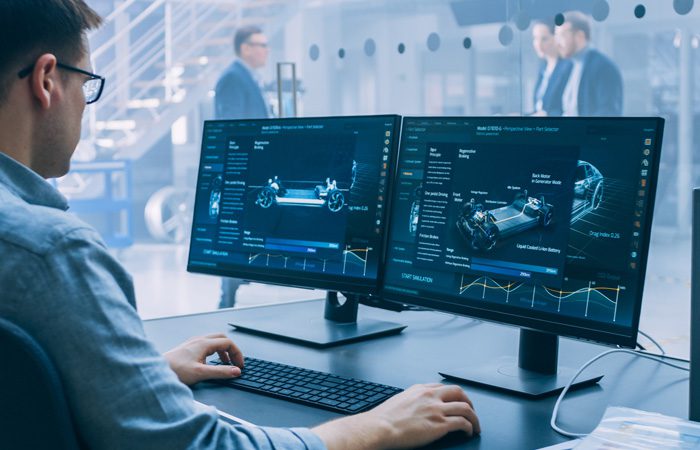
Importance of Custom Plant Design in Achieving Operational Excellence
To remain competitive, companies need to streamline their processes, maximize efficiency, and reduce waste. One of the most critical factors in achieving these objectives is the design of the plant itself. Custom plant design, tailored to the specific needs and operational goals of a company, can be a game-changer in driving operational excellence.
This blog will explore the importance of custom plant design, its impact on operational efficiency, and how partnering with an engineering specialist firm can make this process more effective.
Understanding Custom Plant Design
Custom plant design refers to the process of planning and creating industrial facilities that are specifically tailored to meet the unique needs of a business. Unlike generic or off-the-shelf designs, custom plant designs are developed with a deep understanding of the company’s processes, products, and operational goals. This approach allows for the creation of facilities that are not only more efficient but also more adaptable to future changes and innovations.
Custom plant design involves several key elements, including:
- Process Optimization: Designing a plant layout that optimizes the flow of materials, minimizes bottlenecks, and reduces waste.
- Energy Efficiency: Incorporating energy-saving technologies and practices to reduce operating costs and environmental impact.
- Scalability: Ensuring that the plant design can accommodate future growth and changes in production demands.
- Safety and Compliance: Designing with safety regulations and industry standards in mind to ensure the well-being of employees and the environment.
- Technology Integration: Incorporating the latest technologies, such as automation and data analytics, to enhance productivity and decision-making.
The Role of Custom Plant Design in Operational Excellence
Operational excellence is achieved when a company consistently meets or exceeds its operational goals. This includes maximizing production efficiency, minimizing downtime, and reducing costs. Custom plant design plays a critical role in achieving these objectives by creating an environment that supports optimal performance.
- Enhanced Efficiency: A plant designed with the specific processes of a company in mind can significantly improve efficiency. By optimizing the layout, reducing the distance materials need to travel, and minimizing the number of steps in the production process, companies can increase output and reduce cycle times. This leads to higher productivity and lower operational costs.
- Reduced Downtime: Custom plant design can help reduce downtime by ensuring that equipment is easily accessible for maintenance and repairs. Additionally, the integration of predictive maintenance technologies can help identify potential issues before they lead to costly breakdowns. This proactive approach to maintenance helps keep operations running smoothly and reduces the risk of unplanned outages.
- Improved Safety: Safety is a critical aspect of operational excellence. Custom plant design allows for the creation of facilities that prioritize the safety of employees and the environment. By designing with safety regulations and best practices in mind, companies can reduce the risk of accidents and ensure compliance with industry standards. This not only protects employees but also helps avoid costly fines and legal issues.
- Energy and Resource Efficiency: Custom plant designs can incorporate energy-saving technologies and practices that reduce operating costs and minimize environmental impact. By designing facilities that use resources more efficiently, companies can lower their energy bills and reduce their carbon footprint. This not only benefits the environment but also enhances the company’s reputation and competitiveness in the marketplace.
- Scalability and Flexibility: As businesses grow and evolve, their production needs may change. Custom plant design allows for the creation of facilities that are scalable and adaptable to future changes. Whether it’s expanding production capacity, adding new product lines, or integrating new technologies, a custom-designed plant can be modified to meet the changing needs of the business without requiring a complete overhaul.
The Challenges of Custom Plant Design
While the benefits of custom plant design are clear, the process itself can be complex and challenging. Designing a facility that meets all of the specific needs of a company requires a deep understanding of the business’s processes, products, and goals. It also requires expertise in a wide range of engineering disciplines, including mechanical, electrical, civil, and process engineering.
One of the biggest challenges in custom plant design is ensuring that all of the different elements of the design work together seamlessly. For example, the layout of the plant must be optimized for the flow of materials, while also ensuring that equipment is easily accessible for maintenance. Additionally, the design must incorporate safety and environmental regulations, while also being flexible enough to accommodate future changes.
Another challenge is managing the cost and timeline of the project. Custom plant design can be expensive and time-consuming, and there is often pressure to keep costs down and complete the project as quickly as possible. This requires careful planning, coordination, and project management to ensure that the design meets all of the necessary requirements while staying within budget and on schedule.
How an Engineering Specialist Firm Can Help?
Given the complexity and challenges of custom plant design, many companies choose to partner with an engineering specialist firm to help guide them through the process. These firms have the expertise and experience needed to create custom plant designs that meet the specific needs of a business while also addressing the challenges of the project.
Expertise Across Disciplines: Engineering specialist firms have experts in a wide range of engineering disciplines, including mechanical, electrical, civil, and process engineering. This multidisciplinary approach ensures that all aspects of the plant design are considered and integrated into a cohesive plan. Whether it’s optimizing the layout for efficiency, ensuring compliance with safety regulations, or integrating the latest technologies, these firms have the knowledge and experience to create designs that deliver results.
Advanced Technology Integration: Engineering specialist firms are often at the forefront of technological innovation. They can help companies integrate the latest technologies into their plant designs, such as automation, data analytics, and energy-saving systems. This not only enhances the efficiency and productivity of the plant but also future-proofs the facility by ensuring it can adapt to new technologies and processes as they emerge.
Project Management and Coordination: Managing a custom plant design project requires careful planning and coordination. Engineering specialist firms have project management experts who can oversee the entire process, from initial design through to construction and commissioning. They can help ensure that the project stays on track, meets all of the necessary requirements, and is completed on time and within budget.
Cost Management: Custom plant design can be expensive, but an engineering specialist firm can help manage costs by identifying cost-saving opportunities and ensuring that the design is efficient and optimized. They can also help with value engineering, which involves evaluating different design options to find the most cost-effective solutions without compromising on quality or performance.
Long-Term Support: The relationship with an engineering specialist firm doesn’t end when the plant is built. These firms can provide ongoing support and maintenance services to ensure that the plant continues to operate at peak efficiency. They can also help with future expansions or modifications, ensuring that the plant remains adaptable and scalable as the business grows.
Custom plant design is a critical factor in achieving operational excellence. By creating facilities that are specifically tailored to the needs and goals of a business, companies can improve efficiency, reduce downtime, enhance safety, and lower costs. However, the process of designing a custom plant is complex and challenging, requiring expertise in a wide range of engineering disciplines.
Partnering with an engineering specialist firm can help companies navigate these challenges and create custom plant designs that deliver results. With the right design, businesses can achieve operational excellence and position themselves for long-term success in a competitive marketplace.
The Industrial Internet of Things (IIoT) is transforming the industrial landscape by connecting machines, sensors, and devices, enabling real-time data collection and analysis. This connectivity brings unprecedented efficiency, productivity, and innovation opportunities. However, it also introduces significant cybersecurity risks. As industrial systems become increasingly interconnected, they become more vulnerable to cyber threats, making the security of IIoT systems paramount.
In this blog, we will explore the importance of securing IIoT systems and provide strategies to mitigate cyber threats, addressing the concerns of clients worried about data breaches and security risks.
The Importance of Securing IIoT Systems
- Protecting Critical Infrastructure
IIoT systems are often integrated into critical infrastructure, such as power grids, water treatment facilities, and transportation systems. A cyber attack on these systems can have catastrophic consequences, leading to service disruptions, safety hazards, and economic losses. Ensuring the security of IIoT systems is essential to protect public safety and maintain the continuity of essential services.
- Safeguarding Sensitive Data
IIoT systems collect vast amounts of data, including operational information, production metrics, and even employee and customer data. This data is valuable to cybercriminals who can exploit it for financial gain or industrial espionage. Securing IIoT systems helps protect sensitive data from unauthorized access and theft.
- Maintaining Operational Continuity
Cyber attacks can disrupt industrial operations, leading to downtime and productivity losses. For instance, a ransomware attack can lock down critical systems, forcing companies to halt production until the issue is resolved. By securing IIoT systems, companies can minimize the risk of operational disruptions and ensure business continuity.
- Compliance with Regulations
Many industries are subject to strict regulations regarding data protection and cybersecurity. Non-compliance can result in hefty fines, legal penalties, and reputational damage. Implementing robust IIoT security measures helps companies comply with regulatory requirements and avoid potential legal and financial repercussions.
Strategies to Mitigate Cyber Threats in IIoT Systems
- Implementing Strong Authentication and Access Controls
One of the most effective ways to secure IIoT systems is by implementing strong authentication and access controls. This includes using multi-factor authentication (MFA) to verify user identities and restricting access to sensitive systems and data based on the principle of least privilege. Role-based access control (RBAC) can help ensure that users only have access to the resources they need for their specific roles.
- Encrypting Data at Rest and in Transit
Data encryption is crucial for protecting sensitive information from unauthorized access and tampering. Encrypting data at rest ensures that even if an attacker gains physical access to storage devices, they cannot read the data without the encryption key. Encrypting data in transit protects it from interception and eavesdropping as it moves between devices and systems. Implementing end-to-end encryption ensures that data remains secure throughout its lifecycle.
- Regularly Updating and Patching Systems
Keeping IIoT devices and systems up to date with the latest software patches and security updates is essential for protecting against known vulnerabilities. Cybercriminals often exploit unpatched vulnerabilities to gain access to systems and networks. Regularly updating and patching systems helps close these security gaps and reduces the risk of exploitation.
- Segmenting Networks
Network segmentation involves dividing a network into smaller, isolated segments to limit the spread of cyber threats. By segmenting IIoT networks, companies can contain the impact of a potential breach and prevent attackers from moving laterally across the network. Implementing firewalls, virtual local area networks (VLANs), and intrusion detection systems (IDS) can help enforce network segmentation and enhance security.
- Monitoring and Analyzing Network Traffic
Continuous monitoring and analysis of network traffic can help detect and respond to cyber threats in real time. Implementing intrusion detection and prevention systems (IDPS) can alert security teams to suspicious activity and block malicious traffic.
Advanced threat detection tools, such as Security Information and Event Management (SIEM) systems, can provide comprehensive visibility into network activity and facilitate rapid incident response.
- Implementing Robust Endpoint Security
IIoT devices often have limited security features, making them attractive targets for cybercriminals. Implementing robust endpoint security measures, such as anti-malware software, intrusion prevention systems, and device management solutions, can help protect IIoT devices from cyber threats. Regularly updating firmware and applying security patches is also essential for maintaining the security of IIoT endpoints.
- Conducting Regular Security Assessments and Penetration Testing
Regular security assessments and penetration testing can help identify vulnerabilities in IIoT systems before cybercriminals can exploit them. Conducting these assessments allows companies to proactively address security weaknesses and strengthen their defenses. Engaging third-party security experts to perform penetration testing can provide an unbiased evaluation of the security posture and identify potential areas for improvement.
- Implementing Security Policies and Employee Training
Establishing comprehensive security policies and procedures is essential for guiding the organization’s approach to IIoT security. These policies should cover aspects such as access control, data protection, incident response, and employee responsibilities. Additionally, providing regular cybersecurity training to employees helps raise awareness about cyber threats and promotes best practices for maintaining security. Employees should be educated on how to recognize phishing attempts, secure their devices, and report suspicious activities.
As IIoT systems continue to revolutionize industrial operations, securing these systems against cyber threats becomes increasingly critical. The potential consequences of a cyber attack on IIoT systems, including service disruptions, data breaches, and operational downtime, underscore the importance of robust cybersecurity measures.
By implementing strong authentication and access controls, encrypting data, regularly updating systems, segmenting networks, monitoring network traffic, securing endpoints, conducting security assessments, and fostering a security-aware culture, companies can effectively mitigate cyber threats and protect their industrial assets in a connected world.
Securing IIoT systems is not just a technical challenge; it is a strategic imperative that requires ongoing vigilance and commitment. By prioritizing cybersecurity and adopting a proactive approach, companies can harness the full potential of IIoT while safeguarding their critical infrastructure, sensitive data, and operational continuity. In an era where cyber threats are constantly evolving, a comprehensive and adaptive IIoT security strategy is essential for ensuring a resilient and secure industrial environment.


